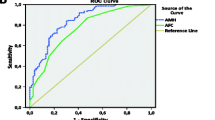Abstract
Purpose
Although studies of serum anti-Müllerian hormone (AMH) in predicting ovarian reserve are numerous, many studies utilized patients under age 40. However, the assessment of ovarian reserve is especially critical in older infertile women. This study evaluates the significance of AMH level in patients over age 40 at the time of their first in vitro fertilization (IVF) treatment.
Methods
Forty-nine women over age 40 were studied. Although serum samples were taken prior to their IVF treatments, the data of serum AMH of patients were not taken into consideration to determine the therapy strategy, including follicle induction in which clomiphene citrate and human menopausal gonadotropin were used.
Result(s)
Twelve out of 49 patients achieved a clinical pregnancy (24.4 %). There was a positive correlation between serum AMH levels and the number of oocytes retrieved (P < 0.0001). The ROC curve analysis for prediction of poor ovarian response, ≤3 retrieved oocytes, showed that the optimum cut-off level was < 1.0 ng/mL for AMH. The lower AMH group (AMH < 1.0 ng/ml) showed less chance of undergoing embryo transfer than the higher AMH group (AMH ≥1.0 ng/ml). There was no difference in pregnancy rate between the two groups. Five out of 12 pregnant women exhibited AMH levels of less than 0.4 ng/ml.
Conclusion(s)
Assessment of serum AMH concentration in older patients is useful for the prediction of oocytes numbers which may be obtained in IVF. A cut-off level of 1.0 ng/ml AMH can be used to predict poor ovarian response. This cut-off level of AMH of 1.0 ng/ml might be useful to predict whether patients could have an embryo transfer, but had no power to predict achieving pregnancy. On the other hand, our data also showed that patients over age 40 with extreme low levels of AMH still had a chance of pregnancy.



Similar content being viewed by others
References
Broekmans FJ, Kwee J, Hendriks DJ, Mol BW, Lambalk CB. A systematic review of tests predicting ovarian reserve and IVF outcome. Hum Reprod Updat. 2006;12(6):685–718.
Broer SL, Mol BWJ, Hendriks D, Broekmans FJM. Role of antimullerian hormone in prediction of outcome after IVF: comparison with the antral follicle count. Fertil Steril. 2009;91(3):705–14.
Ferraretti AP et al. ESHRE consensus on the definition of ‘poor response’ to ovarian stimulation for in vitro fertilization: the Bologna criteria. Human Reprod (Oxford, England). 2011;26(7):1616–24.
Fujimoto A et al. Predictive factors of successful pregnancy after assisted reproductive technology in women aged 40 years and older. Reprod Med Biol. 2009;8(4):145–9.
Khader A et al. External validation of anti-Müllerian hormone based prediction of live birth in assisted conception. J Ovarian Res. 2013;6(1):3.
Leridon H. Demographic effects of the introduction of steroid contraception in developed countries. Hum Reprod Updat. 2006;12(5):603–16.
Lie Fong S et al. Anti-Müllerian hormone: a marker for oocyte quantity, oocyte quality and embryo quality? Reprod Biomed Online. 2008;16(5):664–70.
La Marca A et al. Anti-Mullerian hormone (AMH) as a predictive marker in assisted reproductive technology (ART). Hum Reprod Updat. 2010;16(2):113–30.
La Marca A, Stabile G, Carducci Artenisio A, Volpe A. Serum anti-Mullerian hormone throughout the human menstrual cycle. Human Reprod (Oxford, England). 2006;21(12):3103–7.
Van Rooij IAJ et al. Serum anti-Müllerian hormone levels: a novel measure of ovarian reserve. Human Reprod (Oxford, England). 2002;17(12):3065–71.
Spandorfer SD et al. An analysis of the effect of age on implantation rates. J Assist Reprod Genet. 2000;17(6):303–6.
Spira A. The decline of fecundity with age. Maturitas Suppl. 1988;1:15–22.
Weenen C et al. Anti-Müllerian hormone expression pattern in the human ovary: potential implications for initial and cyclic follicle recruitment. Mol Hum Reprod. 2004;10(2):77–83.
Weghofer A, Dietrich W, Barad DH, Gleicher N. Live birth chances in women with extremely low-serum anti-Mullerian hormone levels. Human Reprod (Oxford, England). 2011;26(7):1905–9.
Acknowledgments
We thank Ms. Mitsuyo Kakimoto for her editorial assistance. We also thank Dr. Heather M. Martinez for her helpful discussion and critical reading of the manuscript.
Grants
This work was supported by Health and Labor Sciences Research Grants from the Ministry of Health, Labor and Welfare of Japan, Grant-in-Aid for Scientific Research from the Ministry of Education, Culture, Sports, Science and Technology.
Author information
Authors and Affiliations
Corresponding author
Additional information
Capsule
In IVF patients over age 40, a cut-off level of 1.0 ng/ml AMH can be used to predict poor ovarian response. But patients with extreme low levels of AMH (<0.4 ng/ml) still had a chance of pregnancy.
Rights and permissions
About this article
Cite this article
Tokura, Y., Yoshino, O., Ogura-Nose, S. et al. The significance of serum anti-Müllerian hormone (AMH) levels in patients over age 40 in first IVF treatment. J Assist Reprod Genet 30, 821–825 (2013). https://doi.org/10.1007/s10815-013-9991-3
Received:
Accepted:
Published:
Issue Date:
DOI: https://doi.org/10.1007/s10815-013-9991-3



